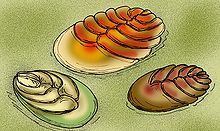Rank Class | ||
 | ||
Similar Vendia, Proarticulata, Praecambridium, Onega stepanovi, Dickinsoniidae | ||
Vendiamorpha top 11 facts
Vendiamorpha is a class of extinct animals within the Ediacaran phylum Proarticulata.
The typical vendiamorph had an oval-shaped or round-shaped body divided completely into segmented isomers, that were arranged alternately in two rows with reference to the longitudinal axis of body. This phenomenon is described as the symmetry of glide reflection. Transverse elements decrease in size from one end to other and are inclined in the same direction. The larger isomers cover the smaller ones externally and the first isomer is much larger than the rest. Typically, the first few, or largest isomers are fused together to form a headshield-like structure, leading some researchers to originally consider them ancestral or related to arthropods, though, overwhelming evidence of them being proarticulatans have since lead researchers to discard this hypothesized relationship.
Some vendiamorphs, e.g., Vendia and Paravendia, supposedly demonstrate a digestive-distributive system consisting of a simple axial tube and lateral appendages, with one lateral appendage corresponding to one isomer.
Class Vendiamorpha currently includes only one Family Vendiidae (originally referred to as Vendomiidae as the type genus Vendomia, before V. menneri was redescribed as a member of Dickinsonia) that consist of species Vendia sokolovi, V. rachiata, Paravendia janae and Kharakhtia nessovi from Ediacaran (Vendian) rocks of the Arkhangelsk Region, Russia.
Pseudovendia, its name refers to the some resemblance of this fossil with imprint of the Vendia sokolovi. Originally, this fossil was interpreted as an arthropod, later as a Proarticulata, then speculated as possibly a frond-like organism. Current scientific consensus now recognizes the poorly preserved holoytype of Pseudovendia as a pseudofossil.
